
Laurel and Hardy were a British-American comedy duo act during the early Classical Hollywood era of American cinema, consisting of Englishman Stan Laurel (1890–1965) and American Oliver Hardy (1892–1957). Starting their career as a duo in the silent film era, they later successfully transitioned to "talkies". From the late 1920s to the mid-1950s, they were internationally famous for their slapstick comedy, with Laurel playing the clumsy, childlike friend to Hardy's pompous bully. Their signature theme song, known as "The Cuckoo Song", "Ku-Ku", or "The Dance of the Cuckoos" was heard over their films' opening credits, and became as emblematic of them as their bowler hats.

The Music Box is a Laurel and Hardy short film comedy released in 1932. It was directed by James Parrott, produced by Hal Roach and distributed by Metro-Goldwyn-Mayer. The film, which depicts the pair attempting to move a piano up a long flight of steps, won the first Academy Award for Best Live Action Short (Comedy) in 1932. In 1997, it was selected for preservation in the National Film Registry by the Library of Congress as being "culturally, historically, or aesthetically significant". The short is widely seen as the most iconic Laurel and Hardy short, with the featured stairs becoming a popular tourist attraction.

Laurel and Hardy were a motion picture comedy team whose official filmography consists of 106 films released between 1921 and 1951. Together they appeared in 34 silent shorts, 45 sound shorts, and 27 full-length sound feature films. In addition to these, Laurel and Hardy appeared in at least 20 foreign-language versions of their films and a promotional film, Galaxy of Stars (1936), produced for European film distributors.

James Henderson Finlayson was a Scottish actor who worked in both silent and sound comedies. Balding, with a fake moustache, he had many trademark comic mannerisms—including his squinting, outraged double-take reactions, and his characteristic exclamation: "D'ooooooh!" He is the best remembered comic foil of Laurel and Hardy.

Big Business is a 1929 silent Laurel and Hardy comedy short subject directed by James W. Horne and supervised by Leo McCarey from a McCarey (uncredited) and H. M. Walker script. The film, largely about tit-for-tat vandalism between Laurel and Hardy as Christmas tree salesmen and the man who rejects them, was deemed culturally significant and entered into the National Film Registry in 1992.

We Faw Down is a silent short subject directed by Leo McCarey starring comedy duo Laurel and Hardy. It was released by Metro-Goldwyn-Mayer on December 29, 1928. It was remade in part with their film Sons of the Desert in 1933.

You're Darn Tootin' is a silent short subject directed by E. Livingston Kennedy starring comedy duo Laurel and Hardy. It was released on April 21, 1928, by Metro-Goldwyn-Mayer.

Unaccustomed As We Are is the first sound film comedy starring Stan Laurel and Oliver Hardy, released on May 4, 1929.
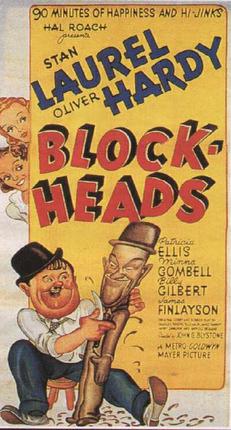
Block-Heads is a 1938 American comedy film directed by John G. Blystone and starring Stan Laurel and Oliver Hardy. It was produced by Hal Roach Studios for Metro-Goldwyn-Mayer. The film, a reworking of elements from the Laurel and Hardy shorts We Faw Down (1928) and Unaccustomed As We Are (1929), was Roach's final film for MGM.

The Finishing Touch is a 1928 short comedy silent film produced by Hal Roach, directed by Clyde Bruckman and starring Laurel and Hardy. It was released February 25, 1928 by Metro-Goldwyn-Mayer.

Should Married Men Go Home? is a silent short subject co-directed by Leo McCarey and James Parrott starring comedy duo Laurel and Hardy. It was released by Metro-Goldwyn-Mayer on September 8, 1928.

Habeas Corpus is a silent short subject co-directed by Leo McCarey and James Parrott starring comedy duo Laurel and Hardy. It was released by Metro-Goldwyn-Mayer on December 1, 1928
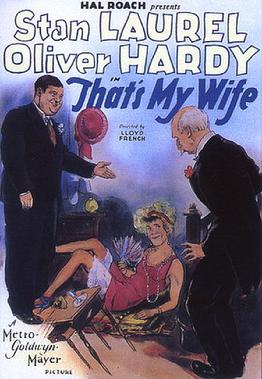
That's My Wife is a 1929 short comedy silent film produced by the Hal Roach Studios and starring Laurel and Hardy. It was shot in December 1928 and released March 23, 1929, by Metro-Goldwyn-Mayer with a synchronized music and sound effects track in theaters equipped for sound.
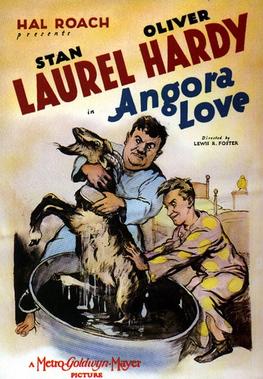
Angora Love is the final silent film made by Laurel and Hardy, released on December 14, 1929.

Another Fine Mess is a 1930 short comedy film directed by James Parrott and starring Laurel and Hardy. It is based on the 1908 play Home from the Honeymoon by Arthur J. Jefferson, Stan Laurel's father, and is a remake of their earlier silent film Duck Soup.
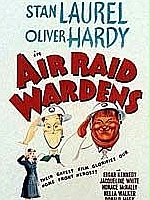
Air Raid Wardens is a 1943 comedy film directed by Edward Sedgwick and starring Laurel and Hardy. It was the first of two feature films starring the duo for Metro-Goldwyn-Mayer.
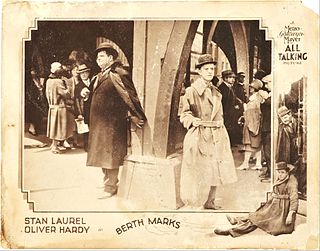
Berth Marks is the second sound film starring Laurel and Hardy and was released on June 1, 1929.

Be Big! is a Hal Roach three-reel comedy starring Laurel and Hardy. It was shot in November and December 1930, and released on February 7, 1931.

Laughing Gravy is a 1931 short film comedy starring Laurel and Hardy. It was directed by James W. Horne, produced by Hal Roach and distributed by Metro-Goldwyn-Mayer.

The Live Ghost is a 1934 American comedy short film starring Laurel and Hardy, directed by Charles Rogers, and produced by Hal Roach at his studios in Culver City, California.




















